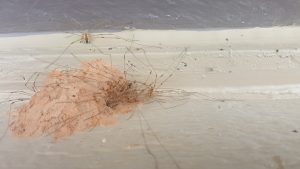Females and males often disagree over reproduction, and this disagreement can manifest in different ways:
1) change in populations that vary in sex ratio
2) development of behaviors that improve the fitness of one sex to the potential detriment of the other
3) coevolution of reproductive armaments that may be used to control the approach and frequency of mating
The ecology of sexual conflict: origins and transitions from appeasement to antagonism

Historical perspectives on mating behavior assumed males and females needed to cooperate in order to reproduce, but increasing evidence suggests conflict is rife throughout the process of mating. In the eastern North American leiobunine harvestmen or “daddy-longlegs,” males of some species give nuptial gifts to females prior to mating. The sac-like structures that assist with nuptial gift transfer are not present in other species groups, and conspicuously, females of these non-sacculate species may have barricade-like structures to limit male access to the pregenital chamber. These male and female morphologies are strongly correlated, but the selection pressures that initiate the increase in antagonistic interactions between the sexes are unclear. We are investigating the roles of geography and long-term demographic shifts in temperate harvestmen groups to understand the selection pressures that influence sexual conflict.
The evolution of sex: why is facultative parthenogenesis rare?

The vast majority of animals on Earth reproduce sexually– but sex is costly in the evolutionary short-term. Female-producing asexual reproduction, parthenogenesis, is quite efficient, but in the long-term leads to an evolutionary dead end. We are studying two species of Japanese harvestmen that are facultative parthenogens, meaning females of these species can reproduce sexually and via parthenogenesis. We hope to learn how this reproductive polymorphism is regulated in natural populations in order to better understand why this mode of reproduction is so rare, despite having the advantages of both parthenogenesis and sex.
Genetics and post-translational modifications of bioadhesive genes
My colleague Dr. Sarah Stellwagen and I are pursuing research on the genetics and evolution of genes that produce glue proteins in arthropods. These proteins are used by in a number of contexts– we are focusing on glues used for prey capture.
Endosymbionts and sex ratio
Wolbachia and Cardinium are reproductive parasites of many terrestrial arthropods and nematodes. Infection may lead to significant changes in the host’s reproduction, including induction of parthenogenesis. We are screening specimens for these bacteria to identify one potential source of long-term demographic change that could lead to relaxated selection on reproductive armaments.

Species delimitation of harvestmen
Like many arachnids, harvestmen are dispersal-limited– they do not produce silk, they are not phoretic, and they appear to rarely leave their natal habitat. As a result, speciation via allopatry is probably extremely common within the leiobunine harvestmen, but despite their widespread nature, taxonomic and phylogenetic species information is severely lacking. In the eastern North American leiobunines, we have identified several well-supported species groups that include both widely-distributed and local endemic species. We will combine morphology and molecular methods in order to delimit these common, yet understudied species.